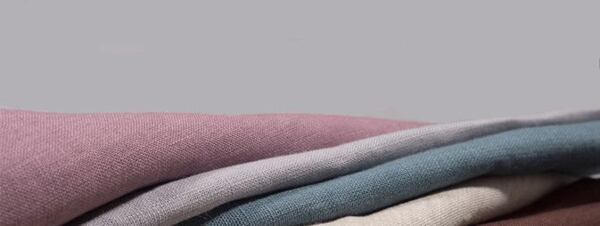
At Sartor we truly love linen and we carry it in a whole range of shades and weights but we know that it can be tough to find your way around without a few touchpoints. Things can get especially confusing if you’re shopping various merchants at the same time – some give weights in ounces, others in grams, some not at all.
Softened linen feels finer
How a fabric feels – its hand and drape – is influenced by a number of factors besides weight, including whether it has been pre-softened (or sanforized). Sanforized linen has a softer hand, doesn’t itch, and drapes well right from the start. Untreated linen is rougher and stiffer and will require repeated washings before it eventually softens – sanforizing speeds up the process so that the fabric you buy is soft on day one.
Unsoftened linen can actually seem heavier than its softened counterpart even if both have the same fabric weight. A medium linen that has been softened will make a billowy sundress just as it is, but an untreated linen of the same weight won’t work as well.
The bulk of our linen fabrics are pre-softened (one exception is our waterproof canvas).
Light as a feather, stiff as a board
It’s best to keep your eye on the numbers, because descriptive labels may differ from shop to shop. What we label as medium might be sold elsewhere as lightweight.
Our fine linen is quite light – it weighs 150 gsm and less. It is good for sewing light garments like blouses, dresses, tunics, and loose, summer pants. Fabrics that weigh under 120 gsm are listed as very fine linen – sometimes referred to as linen batiste, these fabrics are most often used for summer shirts and blouses. Even lighter is linen gauze, a loosely woven, transparent fabric that weighs 80 to 90 gsm and is nice for layered pieces, summer scarves, breezy curtains, or produce sacks.
Medium linen weighs 151–200 gsm – here at Sartor we just call it “linen,” with no weight modifier. This is your classic linen fabric. A medium linen that has been softened works as a universal fabric choice for fashion, home decor, curtains, and bedding.
Heavy linen weighs in at over 200 gsm and lends itself to sturdier garments, like blazers, and interior decor pieces such as heavier curtains and throw pillows. You’ll find it listed in our selection as heavy linen when the fabric is similar to classic medium linen with a similar density of weave, just heavier. We use the descriptor rustic linen for heavy linen fabrics that are woven with a thicker yarn and therefore have a rougher, more tactile structure. Linen fabrics that weigh more than 280 gsm may be labeled as extra heavy, but you wouldn’t use them for garment making – they are better suited for tote bags, awnings for vending stands, and so forth.
Ounces and grams
Most American shops list fabric weights in ounces rather than grams. Some use only descriptive labels – light, medium heavy. The table below gives approximate equivalents.
LIGHT
3.5 oz
up to 150 gsm
MEDIUM
6.5 oz
150-200 gsm
(most common)
HEAVY
over 7 oz
over 200 gsm
EXTRA HEAVY
over 10 oz
over 280 gsm
If you are shopping somewhere other than Sartor, be sure to check whether the linen has been softened (sanforized). Softening has a decided effect on the hand of the fabric.
Linen blends
Linen is often sold in blends with cotton or rayon. The fiber content ratio is usually half and half. It doesn’t affect the weight much, so you can use the same rules of thumb for linen blends as you would for pure linen.
For blends with distinctly different fibers, such as linen and silk, there will be a difference in weight, however.
Which type of linen is your favorite for sewing?
Have you ever used an especially light or heavy linen?
Share your experiences in the comments!








Comments(1)